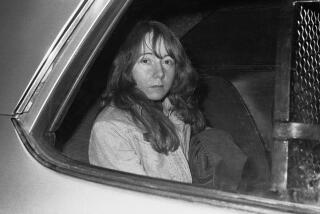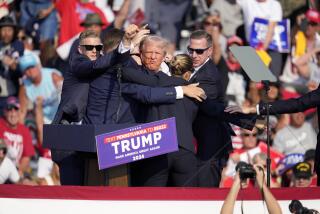MOVIE REVIEWS : A Jolting Look at J.F.K. Assassination
John Barbour’s “The JFK Assassination: The Jim Garrison Tapes” (Laemmle’s Sunset 5, weekend mornings through Nov. 29) has a crucial subject, what may be the crime of the century.
Do we know yet what really happened on Nov. 22, 1963? Or afterward? For some, an increasing minority, these are foolish questions, paranoid presumptions. For them, the mystery was solved long ago by the Warren Commission. Lee Harvey Oswald, a “lone nut” of unusual travel itineraries and chaotic political opinions, possessing a Mannlicher-Carcano rifle capable of ballistic miracles, did the deed, all by himself, from the window of the Texas Book Depository, was quickly captured--but slain a day later in the Dallas police station by another lone nut: strip club owner Jack Ruby.
The dwindling handful who subscribe to this theory will have no interest in Barbour’s film beyond the morbid desire to check out the arguments of the enemy.
For the curious rest of us, “The Garrison Tapes” provides a lucid, excitingly organized and often devastating compendium of many of the arguments that have emerged against the Warren Report: most specifically Jim Garrison’s controversial contention that Kennedy was assassinated by a faction within the CIA.
Barbour’s interview with the late Garrison--who comes across as colorful, magnetic and almost poignantly vulnerable--is the linchpin of the film. But he’s buttressed by a number of others: including lawyer-writer Mark Lane and Dallas witnesses Jean Hill, Ed Hoffman, Roger Craig, Perry Russo, Dr. Robert McClelland of the Parkland medical team and James Leavelle (the cowboy-hatted Dallas officer, handcuffed to Oswald when he was slain).
The movie is packed with information, including a new dip into the FBI files, often persuasive in itself, even more so when assembled as a mosaic. Some of the most damning: the eyewitnesses who claim their testimony was ignored or suppressed by the original investigators--including the deaf-mute Hoffman, who, near the Grassy Knoll, saw a rifle being disassembled and passed to another man after the killing.
There is a photo of a dead ringer for Oswald, standing harmlessly in the Book Depository doorway near the time of the killing. A Dallas Police Dictaphone is replayed, and at least four shots are clearly audible. The Abraham Zapruder film of the assassination once again shows Kennedy’s head apparently being blown backward by rifle fire from in front--instead of behind and above, from the direction of the Depository. One more time, we get the charts on Sen. Arlen Specter’s infamous contribution to American folklore: the “Magic Bullet” from Oswald’s Mannlicher, which supposedly traveled in and out of both Kennedy and Gov. John Connally in a flight pattern resembling a bumblebee’s.
Whether one subscribes to Garrison’s theory or not pales next to the demolition of the Warren Report.
If Oliver Stone’s “JFK” is a brilliant dramatic rendering of the Garrison investigations, then “The JFK Assassination: The Jim Garrison Tapes” (Times-rated: Family) is an excellent documentary companion piece, punchy as a tabloid, vivid as an eyewitness report. Like all good dissident journalism, it jolts, provokes, raises doubts, opens our eyes. And asks, most crucially, that they stay open.
More to Read
Only good movies
Get the Indie Focus newsletter, Mark Olsen's weekly guide to the world of cinema.
You may occasionally receive promotional content from the Los Angeles Times.










